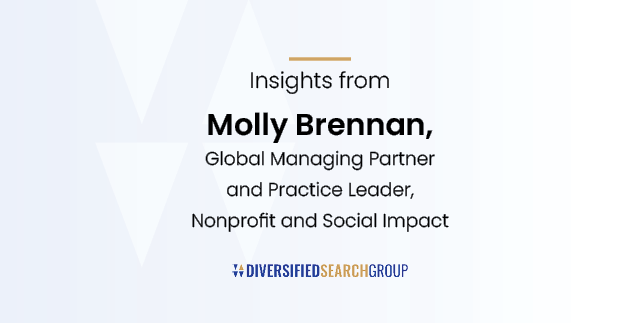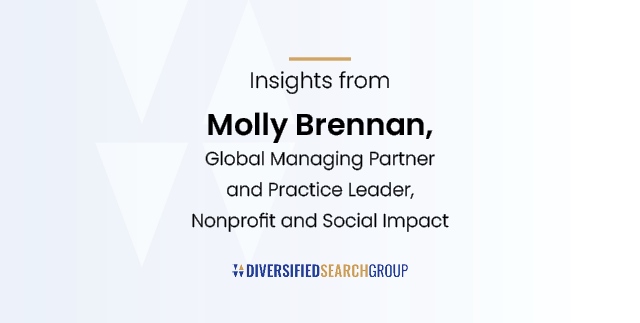Why Hiring Diverse Fundraisers is Essential to Nonprofit Growth Nationwide

Hiring a successful fundraiser is a challenge many nonprofits face. Fundraising positions can remain vacant for months or years. In fact, the average tenure of the role is just 18 months according to a CompassPoint survey, and 50% of fundraisers are actively seeking another job. The position has commonly been referred to as a “revolving door,” yet it’s a critical role for the sustainability and growth of any nonprofit.
Many factors contribute to this problem including an inadequate and uneven talent pool, difficultly assessing and evaluating the position, lack of support from within the nonprofit, and unrealistic expectations of the skills required for the role.
Diverse fundraisers perform better
Another contributing factor many organizations overlook is the lack of ethnic and racial diversity in the role. The Association of Fundraising Professionals (AFP), which fosters the development and growth of fundraising professionals and promotes high ethical standards in the fundraising profession, found that out of its 11,269 U.S. based members, 89% are Caucasian, 3% are African American, 3% are Hispanic and so on.
Research unequivocally shows, however, that diverse teams of varying ethnic and racial makeup produce positive results for organizations. Organizations with diverse teams are better at problem solving and produce more creative and effective products and services. As a result, they perform better financially, gain a competitive edge when recruiting top talent, experience less employee turnover, and offer greater benefits for customers.
In an article published by The Nonprofit Times, Emmett Carson, Ph.D., president and chief executive officer of the Silicon Valley Community Foundation, makes the argument that fundraising in the 21st century will require a different approach based on the interests, values, and traditions of the many rather than a one-size-fits-all approach based on the interests, values, and traditions of white Americans. As people of color become majorities in communities across America, successful nonprofit organizations will need to have a diverse donor base to sustain and grow their operations.
The most successful nonprofits “will realize that to attract and maintain a diversified funding base will require that their boards, staff, and programming also be diverse. Nothing less than a complete transformation in this regard will be sufficient,” says Carson.
Our firm, Koya Leadership Partners, a national executive search firm working with the nonprofit sector to achieve social and lasting change, recently worked with Kishshana Palmer, a woman of color, to place her in a new role as VP of External Affairs for FoodCorps. With more than 10 years of experience advising nonprofits on donor board development, internal fundraising operations and strategic planning, Palmer has seen both the barriers and the opportunities organizations face when recruiting for the role.
Raising awareness of the profession
“One of the main challenges in recruiting diverse candidates is a general lack in awareness of the role,” said Palmer. “Many people, including diverse candidates don’t know they can get into the position, so there is a lack of diverse candidates applying to these roles.”
Part of the issue stems from the fundraising role being a relatively new position. While many colleges and universities are offering fundraising degrees today, there was no such thing 10 years ago. It’s taking a while for potential employees including those of a diverse background to realize this is a profession they can get into.
It’s important for nonprofit organizations looking to recruit diverse fundraising candidates to communicate how essential their role is to the organization’s growing fundraising capacity and to educate the broader public on how it’s a perfect role for anybody orientated towards people.
“You have the opportunity to meet and learn a lot about different people,” Palmer says. “It’s not just about asking people for money. There is a whole lot that goes into the role – prior to making ‘the ask,’ and after. It’s a role with a lot of potential for diverse candidates, and I just don’t think many people realize that.”
Connecting with donors
Another stumbling block is the perception that most donors are wealthy white males. Many diverse professionals may see this as a barrier to getting into the profession.
According to the Huffington Post 64% of donations are made by women and the Chronicle of Philanthropy notes that middle-class Americans give a far bigger share of their discretionary incomes to charities than the rich.
A study by Blackbaud also found that while a majority of donors do tend to be white Americans, African Americans and Hispanics are underrepresented in the donor spectrum. The study noted that white donors are not “more generous” than other racial and ethnic groups. Instead, factors such as income and religious engagement were found to be more significant predictors of giving behavior than race or ethnicity. African-American and Hispanics represented in the study suggested that organized philanthropy is not doing enough to engage non-white communities, and many also said they were solicited less frequently.
The most important aspect of fundraising is not in sharing a similar culture with the donor – although it can be helpful – but rather being able to make the connection with the person you are seeking the donation. Sometimes it just takes time to figure out how to make this connection.
Nonprofits hiring for this role should be looking for people who are good relationship builders and are able to sell the organization and the potential possibilities the organization can offer the donor. Being able to relationship build or make the connection is about finding out if the organization you represent is the proper vehicle for them to give, Palmer says.
Setting expectations
Many nonprofits have an unrealistic idea of the fundraising professional they want to hire. The individual needs to have operational skills, be a front-line fundraiser, manager, and be able to think strategically.
It’s also common to make the mistake of attaching a dollar amount to years of experience. For example, only considering candidates who have obtained a $100,000 gift for their previous organization. Qualifications such as this can be very misleading, because the actual role of the fundraising candidate can often times be unclear. Their previous role may have required them to play a more managerial role while their staff did the actual work behind attaining the gift.
“What’s more important is the candidate’s ability to build affinity. The skillset needed to do the work,” Palmer explains. “When hiring for the position of a fundraiser, nonprofits should ask candidates to walk them through how they acquired the gift instead of focusing on the dollar amount. Oftentimes a non-traditional candidate without the dollar amount to back them up, may be a better fit for the role.”
Providing the Right Support
Finally, during the hiring process it’s also a good idea for the hiring team and the diverse fundraising candidate to have an honest talk about the structure of how teams within the organization work and how they can best be part of the team. For example, does the organization operate in a hierarchical structure, social venture, or flat partnership? The hiring team should be sensitive to the candidate’s social orientation as their background and life experience may factor into the candidate being more apt to flourish in one team structure versus another.
There are many factors that play into a diverse candidate’s power dynamic including color, class, educational pedigree. These factors can be incredibly nuanced and if the candidate doesn’t have the experience in working within a certain team structure, they may be ill-equipped to be successful in the role. If selected for the role, it will be important to have the necessary resources and tools the candidate will need to adjust and grow in their new role.
When a candidate’s social orientation is different than that of the organization’s, it’s essential that managers match the new hire with the right mentor to help them adjust to the new role. Someone who can help him or her adjust to the organization’s structure and approach.
The lack in diversity of fundraising professionals across the U.S. is a hurdle for nonprofits. Although there is no one-size-fits-all solution, nonprofits can take the first step by making a commitment to fund and provide the resources necessary to improve the hiring process. Doing so will not only improve the organization’s fundraising program in the long run, but may help solve the industry’s ongoing challenge in hiring successful fundraisers.




